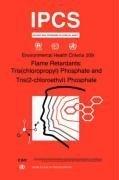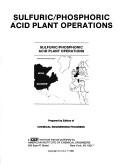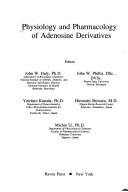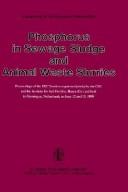
ISBN: 9241572094 Year: 1999 Volume: 209
Abstract | Keywords | Export | Availability | Bookmark
 Loading...
Loading...Choose an application
- Reference Manager
- EndNote
- RefWorks (Direct export to RefWorks)
Blootstelling aan het milieu --- Environmental exposure --- Exposition environmentale --- Exposure [Environmental ] --- Milieu [Blootstelling aan het ] --- Phosphoric acid esters --- Toxicity --- Adverse effects --- Fireproofing agents

ISBN: 0816902216 9780816902217 Year: 1982 Publisher: New York (N.Y.): American institute of chemical engineers
Abstract | Keywords | Export | Availability | Bookmark
 Loading...
Loading...Choose an application
- Reference Manager
- EndNote
- RefWorks (Direct export to RefWorks)
Phosphoric acid --- Sulfuric acid --- Battery acid --- Electrolyte acid --- Hydrogen sulfate --- Oil of vitriol --- Oleum --- Sulphuric acid --- Vitriol, Oil of --- Inorganic acids --- Sulfur acids --- Phosphorus compounds
Dissertation
ISBN: 9789088260384 Year: 2007 Volume: 771 Publisher: Leuven Katholieke Universiteit Leuven
Abstract | Keywords | Export | Availability | Bookmark
 Loading...
Loading...Choose an application
- Reference Manager
- EndNote
- RefWorks (Direct export to RefWorks)
Within-field variability of the plant-available nutrients often results in different fertiliser requirements across a field. Variable rate (VR) fertilisation is one of the advanced techniques in precision agriculture. The VR strategy for P (VRP) is based on standard soil test for P in sampling grid of one hectare for large agricultural fields. The study of spatial variability of soil P within a field revealed that, VRP should be implemented over small areas (perhaps down to few square meters). This can be achieved with an on-the-go P fertilisation system. For on-the-go P fertilisation, three important elements are required: a soil sensor to gather soil information while travelling across a field, a model to derive the actual soil P and a recommendation model to predict corresponding application rate. A VIS-NIR soil sensor for on-the-go gathering of soil spectra (Mouazen et al, 2005) was installed at the front of a planter-applicator for on-the-go gathering of soil spectra. The optical sensor unit to measure soil reflectance spectra was attached to a mobile, fibre-type, VIS-NIR spectrophotometer (CORONA FIBRE VISNIR 1.7, Carl Zeiss) with a measurement range of 305 - 1711 nm. Two visible (VIS) and near infrared (NIR) models were developed for prediction of soil P using wet soils based on soil samples that were collected from Belgium and Northern France. These models were calibrated based on two different measures of soil available P: Olsen P and ammonium lactate extractable P (Pal). The performance of the models was validated by different methodologies. The accuracy of the model was verified using several independent field samples. Since in Belgium the phosphate is recommended based on Pal test, the model developed (Mouazen et al, 2007) based on the Pal was used as basis for VR fertilisation system developed for this dissertation. Another challenge to on-the-go P application is fertiliser recommendation. Generally, fertiliser recommendation is based on many factors rather than just measured soil P. These include soil type, pH, other soil nutrients and soil moisture content. These soil parameters must be simultaneously measured in addition to soil P for actual fertiliser recommendation. Since, for the present research these factors were not available in on-the-go measurements, a recommendation model was established solely based on soil Pal measure. This simplified model was derived from the information provided by Soil Service of Belgium rather than based on the Expert System (Vandendriessche et al., 1993 & 1995) for precise fertiliser recommendation that uses many of the above mentioned parameters. The fertiliser recommendation based on this simplified model could sometimes fail due to ignoring other factors. But this could be remedied in future. A programme (LabVIEW, National Instrument) was developed to record soil spectra, predict soil Pal during on-the-go measurement and calculate required P fertiliser amount. This algorithm provided the signal to the VR fertiliser applicator (ED302, AMAZONE) to change the application rate accordingly. In addition, the coordinates of the sampling points were recorded using a DGPS (Trimble® AgDGPS 132) that was included to document the soil and fertiliser maps, although, for a sensor-based VR application system this positioning system is not required. In an experimental field alternative plots were selected so that every other plot was used for VR application as for uniform rate (UR) treatment. Maize was planted over the entire field. During the planting, only the plots assigned for VR treatment received the rates recommended by on-the-go measurement and the rest received a uniform dose of 30 kg P2O5/ha based on the standard Pal measurement and recommendation by the Soil Service of Belgium. The location of the collected soil P spectra and the corresponding phosphate application rate was recorded using a DGPS. The number of plant leaves and grain yield were considered as growth indices, which might be influenced by P deficiency. The maize was harvested using a combine harvester (CR 960 New Holland) instrumented with a continuous grain flow sensor (New Holland) and a DGPS, which allowed positioning the grain yield while travelling across the field. The plant leaves and crop yield showed lower variation in plots assigned for VR treatment compared to those of UR treatment (coefficient of variation of 25 and 31%, respectively). This may be due to the proper distribution of the fertiliser according to soil requirement. No significant difference was found for the number of plant leaves between VR and UR plots. However, the yield of the plots with the VR treatment was significantly higher than for the UR treatment. Yield increase of 336 kg grain/ha was observed in the VR plots. However, the experimental layout of the plots could not be properly designed using a statistical randomisation method because of the limitation imposed by the machine operation. Therefore, this result needs further investigation to be confirmed. Average application rate of phosphate on VR plots was 28.75 kg P2O5/ha which is 1.25 kg P2O5/ha lower than the recommended UR (30 kg P2O5/ha). This implies that the benefit of using VR strategy is minor in agricultural fields with a high level of soil Pal which is the case for most of the Belgian fields.
Academic collection --- 631.333 --- 631.85 --- 631.416.2 --- Fertilizer distributors. Manure spreaders. Machines and equipment for fertilizer preparation and distribution --- Phosphate fertilizers --- Phosphoric acid --- Theses --- 631.416.2 Phosphoric acid --- 631.85 Phosphate fertilizers --- 631.333 Fertilizer distributors. Manure spreaders. Machines and equipment for fertilizer preparation and distribution
Book
ISBN: 9981867020 Year: 1994 Publisher: Paris Imphos - World phosphate institute
Abstract | Keywords | Export | Availability | Bookmark
 Loading...
Loading...Choose an application
- Reference Manager
- EndNote
- RefWorks (Direct export to RefWorks)
631.85 --- 631.416.2 --- 636.085.1 --- 631.811.2 --- 546.18 --- Phosphate fertilizers --- Phosphoric acid --- Composition of feedstuffs --- Phosphorus. P --- Phosphorus P --- Conferences - Meetings --- 546.18 Phosphorus P --- 631.811.2 Phosphorus. P --- 636.085.1 Composition of feedstuffs --- 631.416.2 Phosphoric acid --- 631.85 Phosphate fertilizers
Book
ISBN: 9251059292 9789251059296 Year: 2008 Publisher: Rome FAO
Abstract | Keywords | Export | Availability | Bookmark
 Loading...
Loading...Choose an application
- Reference Manager
- EndNote
- RefWorks (Direct export to RefWorks)
Phosphatic fertilizers. --- Phosphorus in agriculture. --- Soils --- Environmental Sciences and Forestry. Soil Science --- Phosphorus content. --- Soil Chemistry. --- Phosphatic fertilizers --- Phosphorus in agriculture --- 631.416.2 --- 631.85 --- Phosphorus --- Agriculture --- Phosphate fertilizers --- Phosphorus fertilizers --- Fertilizers --- Phosphates --- 631.85 Phosphate fertilizers --- 631.416.2 Phosphoric acid --- Phosphoric acid --- Phosphorus content
Book
ISBN: 929066200X Year: 1991 Publisher: Patancheru ICRISAT
Abstract | Keywords | Export | Availability | Bookmark
 Loading...
Loading...Choose an application
- Reference Manager
- EndNote
- RefWorks (Direct export to RefWorks)
Contributed papers of international workshop helt at ICRISAT Center, Patancheru on 8-11 Jan. 1990.
Phosphore --- Phosphorus --- Légumineuse à grains --- Grain legumes --- Fertilisation --- Fertilizer application --- Substance nutritive minérale --- Mineral nutrients --- Engrais phosphaté --- Phosphate fertilizers --- Mycorhizé --- Mycorrhizae --- Zone semi-aride --- Semiarid zones --- Zone tropicale --- Tropical zones --- Cicer arietinum --- Cajanus cajan --- Exsudat racinaire --- Root exudates --- 631.85 --- 635.65 --- 581.133.5 --- 631.416.2 --- Pulses. Vicia and others --- Assimilation of phosphorus --- Phosphoric acid --- 631.416.2 Phosphoric acid --- 581.133.5 Assimilation of phosphorus --- 635.65 Pulses. Vicia and others --- 631.85 Phosphate fertilizers --- Icrisat
Dissertation
ISBN: 9059891112 Year: 2006 Publisher: Gent Universiteit Gent. Faculteit Bio-ingenieurswetenschappen
Abstract | Keywords | Export | Availability | Bookmark
 Loading...
Loading...Choose an application
- Reference Manager
- EndNote
- RefWorks (Direct export to RefWorks)
Érosion hydrique --- Water erosion --- Eau superficielle --- Surface water --- Sédiment --- Sediment --- Eutrophisation --- Eutrophication --- Phosphore --- Phosphorus --- Lessivage du sol --- Leaching --- Précipitation --- precipitation --- Type de sol --- soil types --- Expérimentation en laboratoire --- Laboratory experimentation --- Expérimentation au champ --- Field experimentation --- Mesure --- Measurement --- Belgium --- 631.432.3 --- 631.416.2 --- 631.421.1 --- Permeability. Lessivage. Leaching. Mobility of soil constituents --- Phosphoric acid --- Field experiments. Field trials --- Theses --- 631.421.1 Field experiments. Field trials --- 631.416.2 Phosphoric acid --- 631.432.3 Permeability. Lessivage. Leaching. Mobility of soil constituents --- Sediment. --- precipitation.

ISBN: 0890048339 9780890048337 Year: 1983 Publisher: New York (N.Y.): Raven Press
Abstract | Keywords | Export | Availability | Bookmark
 Loading...
Loading...Choose an application
- Reference Manager
- EndNote
- RefWorks (Direct export to RefWorks)
Adenylic acid --- Adenosine --- Adenine nucleotides --- Neurotransmitters --- Physiological effect --- Testing --- Congresses --- -Adenosine --- -Adenylic acid --- -Neurotransmitters --- #Lilly --- Chemical nerve transmitters --- Nerve transmitter substances --- Neural transmitters --- Neurohumors --- Neuroregulators --- Synaptic transmitters --- Transmitters, Chemical nerve --- Transmitters, Synaptic --- Neurochemistry --- Neural transmission --- Adenine ribonucleotide --- Adenine-ribose phosphate --- Adenosine monophosphate --- Adenosine phosphate --- Adenosine phosphoric acid --- AMP (Biochemistry) --- Adenine --- Adenine nucleoside phosphates --- Adenosine phosphates --- Purine nucleotides --- Adenocard --- Adenoscan --- Purine nucleosides --- Ribonucleosides --- Adenylic acid - Physiological effect --- Adenosine - Physiological effect --- Adenosine - Testing --- Adenine nucleotides - Congresses --- Adenosine pharmacology --- Adenosine physiology

ISBN: 9027703175 9789027703170 Year: 1981 Volume: 7112 Publisher: Dordrecht Reidel
Abstract | Keywords | Export | Availability | Bookmark
 Loading...
Loading...Choose an application
- Reference Manager
- EndNote
- RefWorks (Direct export to RefWorks)
Soils --- Phosphorus --- Sewage sludge --- Animal waste --- Phosphorus content --- Congresses --- Environmental aspects --- 631.416.2 --- 631.879.2 --- 636.002.68 --- 631.862 --- -Phosphorus --- -Sewage sludge --- -Soils --- -Earth (Soils) --- Mold, Vegetable --- Mould, Vegetable --- Soil --- Vegetable mold --- Agricultural resources --- Plant growing media --- Regolith --- Land capability for agriculture --- Biosolids --- Sludge, Sewage --- Sewage disposal --- Group 15 elements --- Nonmetals --- Farm waste --- Livestock waste --- Packing-house waste --- Slaughtering and slaughter-houses --- Agricultural wastes --- Factory and trade waste --- Phosphoric acid --- Sewage as fertilizer --- Animal wastes. Animal dung. Animal manure--(as a problem) --- Farmyard manure. Animal dung. Stable muck (including sullage, liquid manure) --- -Congresses --- Waste --- -Phosphoric acid --- 631.862 Farmyard manure. Animal dung. Stable muck (including sullage, liquid manure) --- 636.002.68 Animal wastes. Animal dung. Animal manure--(as a problem) --- 631.879.2 Sewage as fertilizer --- 631.416.2 Phosphoric acid --- -631.862 Farmyard manure. Animal dung. Stable muck (including sullage, liquid manure) --- Earth (Soils) --- Environmental aspects&delete& --- Phosphorus content&delete& --- Soils - Phosphorus content - Congresses --- Phosphorus - Environmental aspects - Congresses --- Sewage sludge - Congresses --- Animal waste - Congresses
Book
ISBN: 3039289403 303928939X Year: 2020 Publisher: MDPI - Multidisciplinary Digital Publishing Institute
Abstract | Keywords | Export | Availability | Bookmark
 Loading...
Loading...Choose an application
- Reference Manager
- EndNote
- RefWorks (Direct export to RefWorks)
The development of new technologies and the increasing demand for mineral resources from emerging countries are responsible for significant tensions in the pricing of non-ferrous metals. Some metals have become strategic and critical because they are used in many technological applications such as flat panel TVs (indium), solar panel cells (indium), lithium-ion batteries for electric vehicles (lithium, cobalt), magnets (rare earth elements, such as neodymium and dysprosium), scintillators (rare earths), and aviation and medical applications (titanium); their availabilities remain limited. The secured supply of these metals is crucial to continue producing and exporting these technologies, and because the specific properties of these metals make them essential and difficult to substitute for a given industrial application. Hydrometallurgy have the advantages of being able to process low-grade ores, to allow better control of co-products, and have a lower environmental impact providing that the hydrometallurgical route is optimized and cheap. The need to develop sustainable, efficient, and cheap processes to extract metals from complex and poor polymetallic matrices is real. The aim of this book was to highlight recent advances related to hydrometallurgy to face new challenges in metal production.
n/a --- gold recovery --- metal extraction --- secondary raw materials --- degradation --- precipitation --- yttrium --- separation --- seawater --- chloride --- chalcopyrite --- metal recovery --- electrochemistry --- solvent extraction --- rare-earth elements --- cuprite --- scandium --- leaching --- surface product --- solid-liquid extraction --- phosphoric acid --- intermediate --- ionic liquids --- mercury ions --- chromium(VI) --- competitive adsorption --- voltammetry --- titanium --- liquid-liquid extraction --- WEEE --- value chain --- fayalite --- gold cyanidation --- reusability --- recovery --- platinum group metals --- refining --- tri-n-octylamine --- red mud --- electroleaching --- Alamine® 336 --- indium --- intensification behavior --- base metal production --- bauxite residue --- hydrometallurgy --- structure --- nickel iron oxide --- pregnant thiosulfate solutions --- resin adsorption technique --- ion exchange resin --- electrodeposition --- back-extraction --- eluent

 Search
Search Feedback
Feedback About
About Help
Help News
News